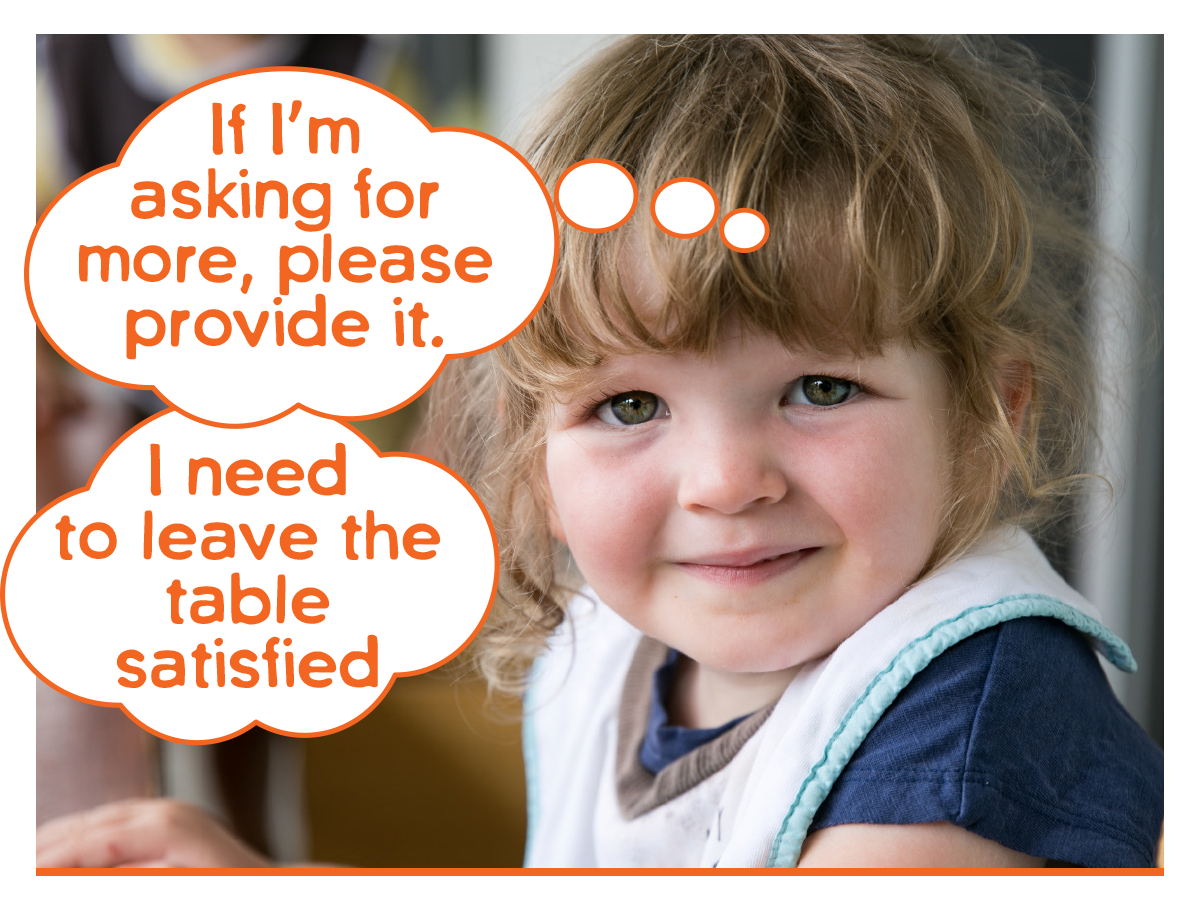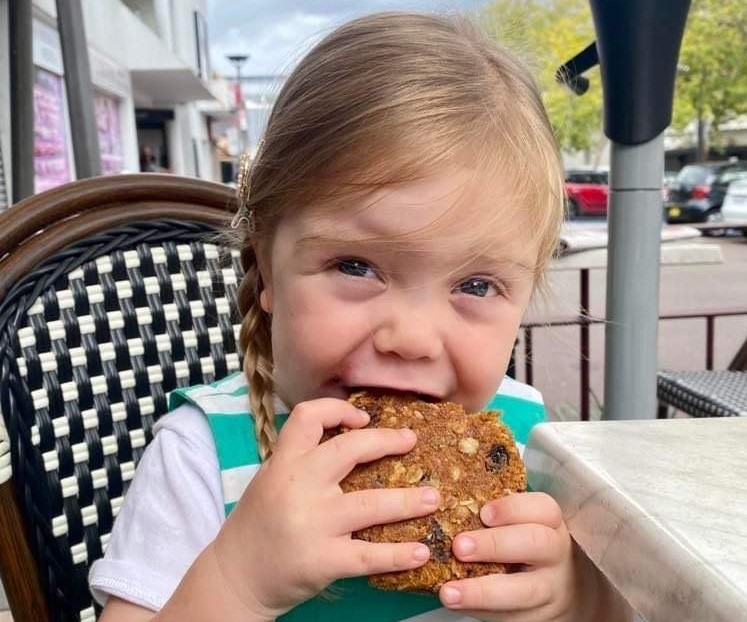Food Restriction
Summary
- Food restriction refers to restricting the amount of food and types of food.
- Children need to eat until they are satisfied, they decide when they’ve had enough.
- We are born knowing how much to eat but this can be disrupted by ‘HOW’ we feed.
- Unsatisfied children can become preoccupied with food and look for food to fill them up.
- Restricting food with children aware can create more desire for that food.
On this page
When to stop eating is always the child’s decision.
What is food restriction?
Food restriction for children is when parents restrict the amount of food or the type of food a child eats.
Restricting the amount of food means we stop our child eating when ‘WE’ want them to stop and before ‘THEY’ are ready. Our children need to feel satisfied at the end of the meal. Your child being able to eat the foods in satisfying amounts gives eating stability. They will learn they don’t have to eat past their fullness signals and can always make the decision when to stop eating.
A child’s food intake will be up and down.
They may not touch some meals and at the next meal they’ll eat lots. We need to trust them at both times.
Restricting the types of food can be done in way that either supports our child’s eating development, or in a way which can have negative results. It’s all about whether out child knows they are being restricted or not. If we have created a situation where a food is available, or we’ve provided it, we need to let them eat until satisfied.
If they know the food is there and you say no, then they’ll want it even more.
Why might we restrict the amount children eat?
There are reasons related to your child and reasons related the parent or carer, that make it more likely that food restriction will be used.
We are more likely to restrict eating if our child appears to eat a lot or if they are larger than other children.

If we ourselves have had battles with weight, view ourselves as overweight or have a negative view of our body, we are more likely to restrict our children’s eating. Mothers are also more likely to restrict their daughters eating than their sons.
In a society which can commonly focus on diets and food restriction, we may think being relaxed about the amount our children eat at meals, may lead to overeating and weight gain. This is not the case. Our children need to find the point they stop eating by themselves knowing this is important to long term health.

It can be suggested by other parents, friends, family and well-meaning health professionals that our child needs to eat less.
This is likely to backfire. If there has been repeated food restriction and our child has lost the ability to regulate their food intake, they need to re-learn how to regulate their intake, by being allowed to eat until satisfaction. Following the feeding roles, setting a reliable meal structure and adequate exposure to foods within the Australian Guide to Healthy Eating will help.
What happens when restricting the amount children eat?
Our hunger and fullness signals
When we restrict the amount our child eats, they will leave the table hungry and dissatisfied. Food can become a child’s priority and they are likely to try and seek out extra food. If this happens consistently, children can learn to overeat when there is unlimited food available, as they can’t guarantee when food will be freely available again.
Children need to learn when they’ve had enough by themselves.
There will be a point when children will be in charge of all their feeding roles. You can’t control how much they eat throughout life. They need to learn how much to eat by themselves.
Until our children’s appetite is disrupted, children know how much to eat:
-
If they are given high fat high sugar foods, they will eat less
-
If they are given too little food, they will look for food to fill them up
-
If they are given large meals, they will eat until full and leave the rest.

Feeding relationship/mental health
Restricting how much your child eats can damage your relationship with them. Just like pressure to eat, when we control what they want to do at the meal, it will become less enjoyable. If you restrict their eating your child will be upset or angry with you and find it confusing.
Restriction can be interpreted by a child as there is something wrong with their body. Restricting children’s food intake has been associated with negative body image, development of eating disorders and suicidal thoughts in adolescence.
Restricting the type of food children eat
There are two ways to restrict the type of food children eat.
Covert Restriction is restricting the type of food a child eats in a way they’re not aware. It is pretty much the parent/ carer deciding which foods to provider. Remember the feeding roles? We decide which foods that our child gets to choose from and therefore we control the nutrition.
Overt Restriction refers to restriction that out child is aware of. For example, keeping biscuits in the cupboards and your children know they’re there, but not letting your child eat them. Taking a child to a birthday party and then not letting them eat some of the foods available. If children are aware of the restriction, it makes them want those foods even more, it creates the desire and the forbidden fruit which is more attractive.


How does this work in our food environment?
Covert restriction or restricting foods in a way our children aren’t aware of can be challenging. It seems everywhere we look we see favourite food advertising or displayed and opportunities to favourite eat foods. There are times when you can’t control what they are exposed to, but most of the time you can. It’s ‘MOST’ of the time that counts.
Once a food is provided then it’s best to let your child choose to eat or not. They have been provided the opportunity to eat even though you may not have planned it.
Supermarkets can be challenging with Covert Restriction
There will be times your control of food provided is challenged. You can always limit these opportunities.
You will still be in control most of the time, to be able ensure they are offered the foods you choose.
Some tips to help us with food restriction
Be sure foods you serve are filling enough so children feel satisfied. A meal of just vegetables or a snack with just fruit can leave your child unsatisfied and they will look for food to fill them up.
Make sure you have a good meal structure. Let your child eat as much as they need at meals, no eating between meals, and give them the opportunity to eat until satisfied at the next meal. For more information visit our meals page.
It’s good to know child portion sizes. Serving large portions can be overwhelming first up. Serve up a child size portion and if they want more, make sure there is more available. Other days they won’t eat much at all.
Portion control is food restriction.
What can they see at home?
Only keep foods in the house that you’re happy feeding your child. If you do have some ‘adult snacks’ for when its adult time i.e. after the kids are in bed, then you need to find a good hiding spot for them!
If you don’t want them eating it… Don’t let them see you eating it!

Create the rules. It’s difficult to always restrict food in a way your child unaware of, like doing a shop and having to stand next to the chocolates at the checkout. Making rules can be helpful. Over time if we stick with them, they’ll know it becomes “not an option”. Your child will learn there is no chance of this rule being relaxed.
Adjust your routine
There can be lots of situations where your child is exposed to or offered foods outside your control. This could be a lollipop at the hairdresser, frankfurt at the butcher or maybe whenever you visit a particular friend or relative. You have the potential to ‘have a chat’ or adjust your routine so these opportunities don’t come up as much. But once these foods have been offered, you have provided the opportunity to eat. You need to leave the decision to eat up to your child.

This might even be the number of birthdays you attend
You have taken them to the party, therefore you provided them with the opportunity to eat. You can’t now restrict what your toddler has at the party. If you feel there is too much unhealthy food in your child’s life and you want to limit it, then a covert way would be to look at how many birthday parties you get invited to and limit them.
- Satter E. Eating Competence: Definition and Evidence for the Satter Eating Competence Model. Journal of Nutrition Education and Behavior. 2007;39(5, Supplement):S142-S53.
- Rollins BY, Savage JS, Fisher JO, Birch LL. Alternatives to restrictive feeding practices to promote self regulation in childhood: A developmental perspective. Pediatric Obesity. 2016; 11(5):326–32. https:// doi.org/10.1111/ijpo.12071 PMID: 26403816
- Birch LL, Fisher JO, Davison KK. Learning to overeat: maternal use of restrictive feeding practices promotes girls’ eating in the absence of hunger. Am J Clin Nutr. 2003;78(2):215-20.
- Birch LL. Child feeding practices and the etiology of obesity. Obesity (Silver Spring). 2006;14(3):343-4.
- Rollins BY, Loken E, Savage JS, Birch LL. Effects of restriction on children’s intake differ by child temperament, food reinforcement, and parent’s chronic use of restriction. Appetite. 2014;73:31-9.
- Fisher JO, Birch LL. Restricting access to palatable foods affects children’s behavioral response, food selection, and intake. Am J Clin Nutr. 1999;69(6):1264-72.
- Fisher JO, Birch LL. Eating in the absence of hunger and overweight in girls from 5 to 7 y of age. Am J Clin Nutr. 2002;76(1):226-31.
- Tylka TL, Eneli IU, Kroon Van Diest AM, Lumeng JC. Which adaptive maternal eating behaviors predict child feeding practices? An examination with mothers of 2- to 5-year-old children. Eat Behav. 2013;14(1):57-63.
- Coulthard H, Blissett J, Harris G. The relationship between parental eating problems and children’s feeding behavior: a selective review of the literature. Eat Behav. 2004;5(2):103-15.
- Jansen E, Mulkens S, Emond Y, Jansen A. From the Garden of Eden to the land of plenty. Restriction of fruit and sweets intake leads to increased fruit and sweets consumption in children. Appetite. 2008 Nov;51(3):570-5. doi: 10.1016/j.appet.2008.04.012. Epub 2008 Apr 22. PMID: 18501474.



